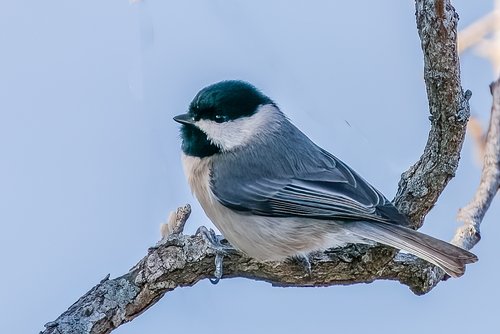
Carolina Chickadee
The Carolina Chickadee (Poecile carolinensis) is a small, non-migratory songbird native to the southeastern United States. It is a familiar sight at backyard feeders and is known for its distinctive 'chick-a-dee-dee-dee' call, from which it gets its name. This active and curious bird plays a vital role in controlling insect populations, particularly during the breeding season when it feeds caterpillars to its young. While not currently considered globally threatened, habitat loss and competition with other species can impact local populations. It holds no particular major cultural significance, other than being a well-loved backyard bird.
9.5-11.5 cm
Length
15-20 cm
Wingspan
Least Concern
Conservation Status
Distribution
The Carolina Chickadee is found exclusively in the southeastern United States. Its range extends from central Texas, Oklahoma, and Kansas eastward to the Atlantic coast, and from southern New Jersey southward to Florida. It has a limited altitudinal range as it is primarily a lowland species.
Lifespan
The average lifespan in the wild is 2-3 years, but some individuals can live up to 10 years.
Carolina Chickadee's Habitat
Habitat Types
Deciduous forests, Mixed woodlands, Forested wetlands, Suburban parks and gardens
Climate Zones
Temperate, Subtropical
Adaptations
Carolina Chickadees are well-adapted to human-altered landscapes, often thriving in suburban areas with sufficient tree cover and food sources. Their small size allows them to exploit a variety of food resources and nest sites.
Variations
Several subspecies of the Carolina Chickadee are recognized, based primarily on subtle differences in plumage color and size. These variations are often clinal, meaning they change gradually across the geographic range.
Appearance
Breeding Plumage
Plumage is similar year-round.
Seasonal Feather Changes
No significant seasonal variations.
Sex Based Plumage Differences
Males and females have very similar plumage.
Notable Features
Black cap and bib, White cheeks, Gray back, wings, and tail, Buffy flanks
Diet and Feeding
Primary Foods
Insects, Spiders, Seeds, Berries
Foraging Behavior
Carolina Chickadees are active foragers, gleaning insects and spiders from leaves, branches, and tree bark. They often hang upside down to search the undersides of branches. They also visit bird feeders, particularly for sunflower seeds and suet.
Specializations
Their small, pointed beaks are well-suited for probing crevices and extracting insects. They also cache food, storing seeds and insects in bark crevices and other hiding places for later retrieval.
Seasonal Diet Variations
Their diet shifts seasonally. During the breeding season, they primarily consume insects and spiders. In winter, they rely more on seeds and berries when insects are less abundant.
Behavior
Social Structure
Carolina Chickadees are generally found in pairs or small family groups during the breeding season. In winter, they often form mixed-species flocks with other small birds, such as titmice and nuthatches.
Communication
Complex vocalizations, including the namesake 'chick-a-dee-dee-dee' call, The 'fee-bee' song, used primarily by males, Various alarm calls to warn of predators
Migration
Carolina Chickadees are non-migratory, remaining in their territories year-round.
Territorial or Group Behaviors
They are territorial during the breeding season, defending their nesting area from other chickadees. In winter, they are less territorial and may join flocks.
Conservation
Threats
Habitat loss due to deforestation and urbanization, Competition with invasive species, such as House Sparrows, for nest cavities, Pesticide use, which can reduce insect prey availability
Protection Programs
General habitat conservation efforts, Provision of nest boxes in areas with limited natural cavities
Local National Laws
Protected under the Migratory Bird Treaty Act in the United States, which prohibits the killing, capturing, selling, trading, and transport of migratory birds without authorization.
Population Trend
Stable
Population Estimates
The global population is estimated to be around 14 million individuals.
Interesting Facts
They have excellent spatial memory
Carolina Chickadees can remember the locations of thousands of food caches, allowing them to survive harsh winters.
The number of 'dees' in their call indicates threat level
More 'dees' in the 'chick-a-dee' call signal a higher level of threat from a predator.
They can lower their body temperature at night
Carolina Chickadees can enter a state of regulated hypothermia, called torpor, to conserve energy during cold nights.
Faqs about Carolina Chickadee
How can I attract Carolina Chickadees to my yard?
Provide a source of fresh water, offer sunflower seeds and suet in feeders, and plant native trees and shrubs that provide food and shelter.
What is the difference between a Carolina Chickadee and a Black-capped Chickadee?
The two species are very similar in appearance. The Carolina Chickadee has less white on the edges of its wing feathers and a slightly faster, higher-pitched call. Their ranges overlap in a narrow zone, where hybridization can occur.
Do Carolina Chickadees reuse their nests?
While they may use the same cavity in subsequent years, they typically build a new nest each breeding season.
Copyright @ Nature Style Limited. All Rights Reserved.
 English
English